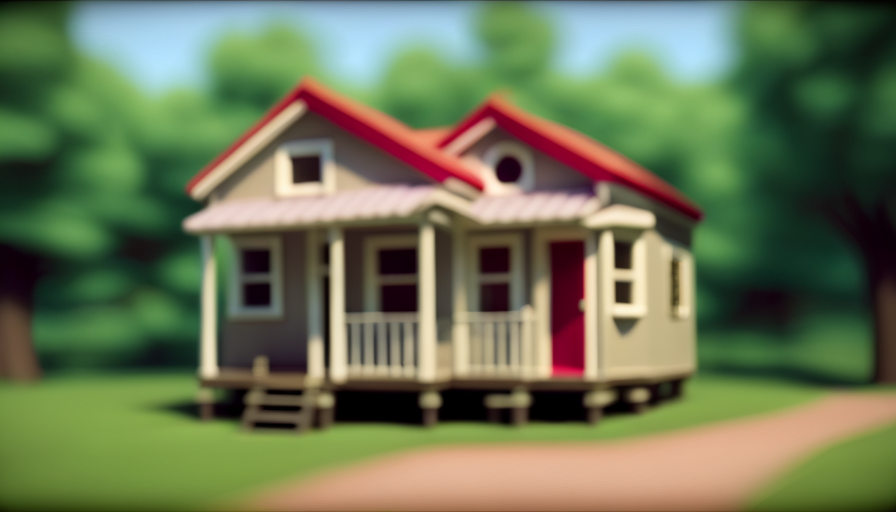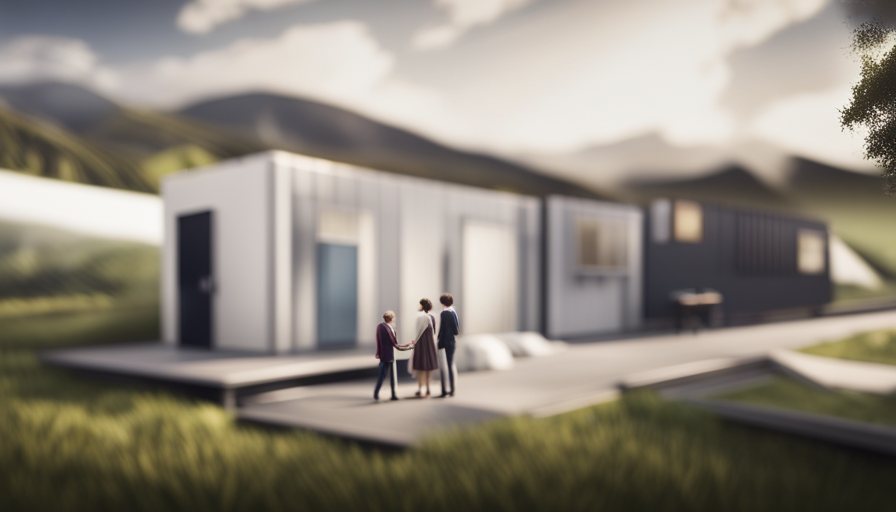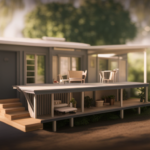Picture this: you’re embarking on a journey to embrace a minimalist lifestyle and build your own tiny house. The prospect of creating a cozy and functional space that reflects your preferences is exciting. But before diving into the construction process, there’s a vital question that needs to be addressed: what is the maximum size a tiny house can be without needing a permit?
In this article, I’ll provide you with all the information you need to navigate the world of tiny house regulations and permits. We’ll explore the maximum dimensions allowed for tiny houses without permits, taking into consideration both on-grid and off-grid options. Additionally, we’ll delve into the importance of understanding local zoning and building codes to ensure your tiny house complies with the rules.
Furthermore, we’ll discuss the art of designing efficient and functional tiny house spaces, maximizing every square inch. In case you’re dreaming of a slightly larger tiny house, we’ll explore alternative options that can help you achieve your vision.
Join me as we dive into the world of tiny house construction, consulting with professionals along the way to ensure we’re on the right path. Let’s get started!
Key Takeaways
- Building a tiny house without a permit requires understanding local zoning and building codes.
- Square footage limitations for tiny houses without permits typically range from 100 to 400 square feet.
- Local regulations may set maximum height restrictions for tiny houses.
- Building codes may require setbacks from property lines, roads, and other structures.
Understanding Tiny House Regulations and Permits
So, you’re probably wondering how big you can go with your tiny house without having to deal with permits, huh? Well, let me break it down for you.
When it comes to tiny house regulations and permits, the size of your tiny house is just one piece of the puzzle. The construction process and common challenges in obtaining permits also play a significant role. It’s important to familiarize yourself with local zoning laws and building codes, as they vary from place to place.
Some areas may have specific requirements for tiny houses, such as minimum square footage or maximum height restrictions. Understanding these regulations can help you navigate the permit process and avoid any potential setbacks.
Now, let’s talk about the maximum dimensions allowed for tiny houses without permits.
Maximum Dimensions Allowed for Tiny Houses without Permits
Surpassing the typical size limitations, how large can one construct their compact dwelling before needing official authorization? When it comes to tiny houses, building codes and legal requirements play a crucial role in determining the maximum dimensions allowed without permits. Here are four key factors to consider:
-
Square footage: Many jurisdictions have specific square footage limitations for tiny houses without permits, typically ranging from 100 to 400 square feet.
-
Height restrictions: Local regulations often set a maximum height for structures, including tiny houses, to ensure they don’t obstruct views or pose safety hazards.
-
Setbacks: Building codes may require tiny houses to be set back a certain distance from property lines, roads, and other structures.
-
Foundation type: Some areas allow tiny houses on wheels without permits, while others require a permanent foundation.
Understanding these building codes and legal requirements is crucial when determining the size of your tiny house. Moving forward, let’s explore the different rules for on-grid and off-grid tiny houses.
Different Rules for On-Grid and Off-Grid Tiny Houses
While exploring the regulations for on-grid and off-grid tiny houses, it becomes clear that the rules governing these dwellings are as distinct as night and day.
When it comes to on-grid tiny houses, which are connected to municipal utilities, there are typically stricter regulations in place. These houses must comply with local zoning and building codes, which often dictate the minimum square footage, setback requirements, and utility connections.
On the other hand, off-grid tiny houses, which are self-sufficient and not connected to municipal services, have more flexibility. They can be built without permits in some areas, as long as they meet certain criteria such as being movable and not permanently affixed to the ground.
However, it’s important to note that building without permits can have legal implications, so it’s crucial to thoroughly research and understand the local regulations before embarking on such a project. Considering local zoning and building codes is essential to ensure compliance and avoid legal issues.
Considering Local Zoning and Building Codes
Make sure to thoroughly research and understand the local zoning and building codes before starting your project, as compliance is crucial to avoid any legal issues. Local zoning restrictions can vary greatly depending on the area, so it’s important to know the specific regulations that apply to your location. These restrictions may include things like minimum lot size, setback requirements, and height limitations. Additionally, building code requirements must be followed to ensure the safety of your tiny house. These codes dictate things like structural integrity, electrical wiring, plumbing systems, and fire safety. To help illustrate the complexity of these regulations, here is a table outlining some common zoning restrictions and building code requirements:
| Zoning Restrictions | Building Code Requirements |
|---|---|
| Minimum lot size | Structural integrity |
| Setback requirements | Electrical wiring |
| Height limitations | Plumbing systems |
| Fire safety |
Understanding and adhering to these local regulations is essential for a smooth and legal tiny house building process. Once you have a clear understanding of the zoning and building code requirements, you can move on to designing efficient and functional tiny house spaces.
Designing Efficient and Functional Tiny House Spaces
Crafting a well-designed tiny home is like painting a masterpiece, where every brushstroke of functionality and efficiency comes together to create a harmonious living space. When designing a tiny house, maximizing storage and optimizing multi-purpose furniture are crucial for making the most of the limited space available.
Innovative storage solutions such as hidden compartments, built-in shelves, and under-bed storage can help keep belongings organized and out of sight. Additionally, utilizing multi-purpose furniture such as convertible beds, fold-out tables, and collapsible chairs can provide flexibility and maximize functionality.
By carefully considering the layout and incorporating these design elements, it is possible to create a tiny house that feels spacious and comfortable. However, for those seeking to build larger tiny houses without permits, alternative options will need to be explored.
Alternative Options for Building Larger Tiny Houses
If you’re dreaming of a spacious and comfortable tiny home, exploring alternative building options without permits can open up a world of possibilities. However, it is important to be aware of building codes and zoning restrictions in your area to ensure that you are not breaking any laws. While building larger tiny houses without permits may seem enticing, it is crucial to consider the potential consequences and drawbacks. One alternative option is to build multiple smaller structures on your property, each within the size limits allowed by local regulations. This allows for more space while still adhering to the rules. Another option is to build your tiny house on wheels, as they are often exempt from certain building codes and permit requirements. Keep in mind that these alternative options may still have limitations and it is advisable to consult with professionals for guidance and advice on navigating the complexities of building without permits.
Consulting with Professionals for Guidance and Advice
Seeking assistance from professionals in the field can be a game-changer when it comes to navigating the complexities of building your dream tiny home within the confines of the law.
When consulting professionals, it’s important to find experts who are knowledgeable about the legal requirements for building structures without permits. These professionals can provide valuable guidance and advice on how to design and construct a larger tiny house while still complying with local regulations. They can help you understand the specific limitations and exemptions in your area and provide insights on how to maximize the space and functionality of your tiny home.
Additionally, they can offer suggestions on alternative building methods and materials that may help you meet legal requirements while still achieving your desired size for your tiny house.
Consulting professionals ensures that you have expert guidance to help you build your tiny home legally and avoid any potential legal issues in the future.
Frequently Asked Questions
How can I determine if my tiny house is considered "on-grid" or "off-grid"?
To determine if a tiny house is considered ‘on-grid’ or ‘off-grid’, there are a few factors to consider. Firstly, ‘on-grid’ refers to being connected to public utilities such as water, electricity, and sewage systems.
Conversely, ‘off-grid’ means being self-sufficient and not relying on these services. This can be achieved through alternative energy sources like solar panels, rainwater collection, and composting toilets. Building an off-grid tiny house offers benefits such as reduced reliance on utility companies, increased sustainability, and the freedom to live in remote locations.
Are there any specific design requirements for tiny houses that don’t require permits?
When building a tiny house without permits, it’s important to consider specific design requirements. These requirements vary depending on the location, but generally focus on safety, sanitation, and structural integrity.
For example, some jurisdictions may require a minimum ceiling height or a specific type of foundation. Additionally, insulation and ventilation standards must be met to ensure comfort and sustainability.
By adhering to these design requirements, you can ensure that your tiny house is built to code, even without permits.
Are there any exceptions to the maximum dimensions allowed for tiny houses without permits?
There are some exceptions to the maximum dimensions allowed for tiny houses without permits. However, it’s important to note that regulations for tiny houses without permits vary depending on the location.
In some areas, there may be restrictions on height, square footage, or number of rooms. It’s crucial to research and understand the specific regulations in your area before building a tiny house without a permit to ensure compliance with the law.
How do I find out about the local zoning and building codes in my area?
Finding local zoning and building codes can be a real adventure! Picture yourself in a maze of regulations, with twists and turns at every corner. But fear not, intrepid explorer!
To navigate this treacherous terrain, start by visiting your local government’s website. Look for the planning or zoning department, where you’ll find treasure troves of information. They’ll have maps, documents, and even contact information for helpful experts who can guide you through the labyrinth of regulations.
Happy hunting!
What kind of professionals should I consult with for guidance and advice when building a tiny house without permits?
When building a tiny house without permits, it’s crucial to consult with professional resources to navigate the legal implications. Architects, contractors, and real estate attorneys are invaluable in providing guidance and advice.
They can ensure compliance with zoning and building codes, offer expertise in design and construction, and help navigate any legal issues that may arise.
Their knowledge and experience will ensure your project is executed in a thorough, detailed, and technically sound manner, mitigating potential risks.
Conclusion
In conclusion, navigating the world of tiny house regulations and permits can be a complex journey. From understanding the maximum dimensions allowed without permits to considering local zoning and building codes, there are many factors to consider.
However, with proper research and consulting professionals for guidance, you can build a tiny house that fits your needs and dreams. Remember, where there’s a will, there’s a way. So, don’t let the size of your tiny house limit your imagination. Think outside the box and create a space that truly reflects your unique style and personality.
In the end, you’ll find that the possibilities are endless, and the rewards are immeasurable.
Hi, I’m Emma. I’m the Editor in Chief of Tiny House 43, a blog all about tiny houses. While tree houses are often associated with childhood, they can be the perfect adult retreat. They offer a cozy space to relax and unwind, surrounded by nature. And since they’re typically built on stilts or raised platforms, they offer stunning views that traditional homes simply can’t match. If you’re looking for a unique and romantic getaway, a tree house tiny house might just be the perfect option.
















